Stan C. Smith's Blog, page 11
October 16, 2023
Life's Great Mysteries - Why does time seem to pass faster when we get older?
Time is weird. I’m going to use a Steve Martin quote, from the movie The Jerk: “I know we’ve only known each other for four weeks and three days, but to me it seems like nine weeks and five days. The first day seemed like a week. The second day seemed like five days, and the third day seemed like a week again, and the fourth day seemed like eight days…”
You get the idea without seeing the entire quote, right?
If time wasn’t weird, science fiction authors (like me) wouldn’t write about time travel so much. It’s just weird. How many people have you heard say that time seems to be passing faster as they get older? Everyone says that, except for babies. Obviously, time doesn’t really pass faster when we get older. If it did, old people would be way out in the future and young people would be stuck in the past.
It’s more about perception. For example, my 63rd year seems like 213 days, and my 64th year will seem like 189 days, and my 65th year will seem like 151 days, and… you get the idea.
Why do we have this perception? To understand this, I’ll refer to Psychology Today, which uses a camera, film, projector, and movie as metaphors to represent visual memory. Consider the frames in a movie. If the camera captures more frames per second, and you play it back at a standard rate of 20 frames per second, the picture seems to be in slow motion. If the camera captures fewer frames per second, and you play it back at the same 20 frames per second, the picture appears faster than real life.
Here’s the kicker… as we age, the visual part of our brain captures fewer visual images per unit of time. We simply have fewer visual images of what is happening around us. Therefore, we have fewer visual memories to draw from as we think about recent events. More actual time passes between the perception of each new mental image. When children remember things, they have more visual images of those events, therefore it seems like those events took longer.
Now I understand why I used to always say, “Are we there yet? Are we there yet?”

Photo Credits:
- Daughter, mother, grandmother with hourglass - DepositPhotos
You get the idea without seeing the entire quote, right?
If time wasn’t weird, science fiction authors (like me) wouldn’t write about time travel so much. It’s just weird. How many people have you heard say that time seems to be passing faster as they get older? Everyone says that, except for babies. Obviously, time doesn’t really pass faster when we get older. If it did, old people would be way out in the future and young people would be stuck in the past.
It’s more about perception. For example, my 63rd year seems like 213 days, and my 64th year will seem like 189 days, and my 65th year will seem like 151 days, and… you get the idea.
Why do we have this perception? To understand this, I’ll refer to Psychology Today, which uses a camera, film, projector, and movie as metaphors to represent visual memory. Consider the frames in a movie. If the camera captures more frames per second, and you play it back at a standard rate of 20 frames per second, the picture seems to be in slow motion. If the camera captures fewer frames per second, and you play it back at the same 20 frames per second, the picture appears faster than real life.
Here’s the kicker… as we age, the visual part of our brain captures fewer visual images per unit of time. We simply have fewer visual images of what is happening around us. Therefore, we have fewer visual memories to draw from as we think about recent events. More actual time passes between the perception of each new mental image. When children remember things, they have more visual images of those events, therefore it seems like those events took longer.
Now I understand why I used to always say, “Are we there yet? Are we there yet?”

Photo Credits:
- Daughter, mother, grandmother with hourglass - DepositPhotos
Published on October 16, 2023 06:47
October 11, 2023
Life's Great Mysteries - Why do hummingbirds fight over the feeder when there is enough for all?
This mystery comes to me every time I watch the hummingbirds at our feeders. You may think of hummingbirds as cute, docile, innocent little fairy-birds, but I’m here to set the record straight. Hummingbirds are mean, grouchy, stingy, food-hoarders. Of course they're still cute, and we like to watch them. However, if they were the size of eagles, they'd be terrifying sky-demons.
Trish fills our feeders whenever they get low. That means the hummingbirds will not run out of food. Ever. There’s plenty for all, including the hummingbird brothers, sisters, cousins, friends, acquaintances, and total strangers. No need to be stingy. There’s no purpose in sitting near the feeder and dive-bombing every other hummingbird that tries to take a sip. There simply is no point in hoarding an unlimited resource.
Well, as it turns out, this unlimited resource thing is the key to hummingbirds’ contentious behavior. Hummingbirds simply cannot fathom that such a thing as an unlimited resource could possibly exist. They did not evolve feeding on unlimited food. If they had, the world would be filled to overflowing with hummingbirds, and nobody wants that.
Hummingbirds feed on nectar, and flowers tend to bloom and produce nectar for a short period of time. The next flower, or group of flowers, may be some distance away. So, throughout all of hummingbird history, about 22 million years, these little bullies have been viciously guarding their food, to make sure they have enough to survive.
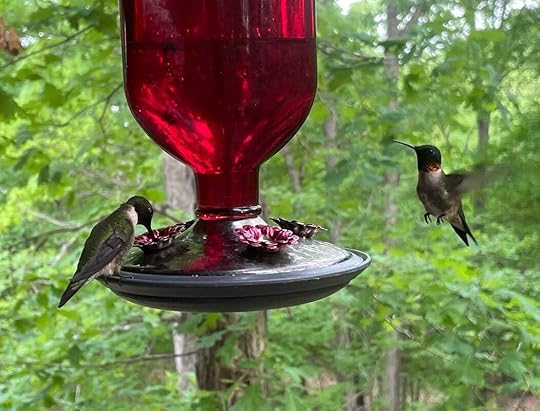
Photo Credit:
Ruby-throated hummingbirdss at feeder - Stan C. Smith
Trish fills our feeders whenever they get low. That means the hummingbirds will not run out of food. Ever. There’s plenty for all, including the hummingbird brothers, sisters, cousins, friends, acquaintances, and total strangers. No need to be stingy. There’s no purpose in sitting near the feeder and dive-bombing every other hummingbird that tries to take a sip. There simply is no point in hoarding an unlimited resource.
Well, as it turns out, this unlimited resource thing is the key to hummingbirds’ contentious behavior. Hummingbirds simply cannot fathom that such a thing as an unlimited resource could possibly exist. They did not evolve feeding on unlimited food. If they had, the world would be filled to overflowing with hummingbirds, and nobody wants that.
Hummingbirds feed on nectar, and flowers tend to bloom and produce nectar for a short period of time. The next flower, or group of flowers, may be some distance away. So, throughout all of hummingbird history, about 22 million years, these little bullies have been viciously guarding their food, to make sure they have enough to survive.

Photo Credit:
Ruby-throated hummingbirdss at feeder - Stan C. Smith
Published on October 11, 2023 06:36
October 7, 2023
Awesome Animal Fact - Blue jays like to mimic hawks
Did you know blue jays often mimic the calls of hawks, but no one really knows why? Blue jays, extremely common birds throughout the eastern half of North America, have a reputation for being bold and raucous. Despite their reputation, though, there's no denying that they are stunningly beautiful birds.
Blue jays are especially skilled at mimicking red-tail hawks and red-shouldered hawks, but they also mimic broad-winged hawks, Cooper's hawks, ospreys, kestrels, and bald eagles. The question is... why?
No one knows for sure. Here are some of the suggested reasons:
1. To attract a mate
Blue jays often imitate hawks during mating season. Maybe part of impressing a mate is to demonstrate that you can imitate a variety of different calls...?
2. To defend their territory
Blue jays hate other animals coming near their nests, so maybe mimicking a hawk might scare off potential nest invaders.
3. To let other blue jays know a hawk is nearby
Hawks prey on blue jays. So, what better way to warn other jays that a hawk is near than to imitate a hawk call. Assuming, of course, that other jays can tell the difference between a fake hawk call and a real hawk call.
4. To fool other birds into thinking a hawk is near
Blue jays are mischievous, right? Why wouldn't they scare other birds away from a food source, to get all the food for themselves? People have actually observed blue jays mimicking hawks to make other birds drop bits of food, then the jays swoop and steal the food.
Hmm... I'm leaning toward #4. In my opinion, blue jays are definitely sneaky (and smart). What do you think?
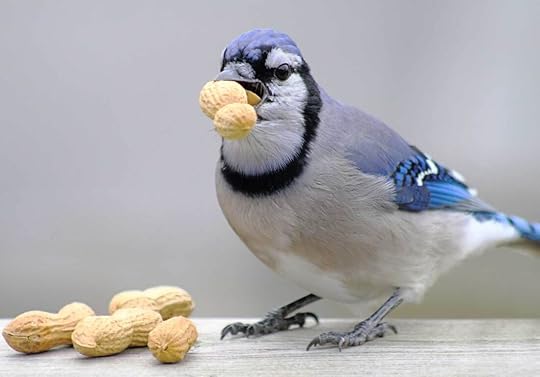
Photo Credits:
- Blue jay - DepositPhotos
Blue jays are especially skilled at mimicking red-tail hawks and red-shouldered hawks, but they also mimic broad-winged hawks, Cooper's hawks, ospreys, kestrels, and bald eagles. The question is... why?
No one knows for sure. Here are some of the suggested reasons:
1. To attract a mate
Blue jays often imitate hawks during mating season. Maybe part of impressing a mate is to demonstrate that you can imitate a variety of different calls...?
2. To defend their territory
Blue jays hate other animals coming near their nests, so maybe mimicking a hawk might scare off potential nest invaders.
3. To let other blue jays know a hawk is nearby
Hawks prey on blue jays. So, what better way to warn other jays that a hawk is near than to imitate a hawk call. Assuming, of course, that other jays can tell the difference between a fake hawk call and a real hawk call.
4. To fool other birds into thinking a hawk is near
Blue jays are mischievous, right? Why wouldn't they scare other birds away from a food source, to get all the food for themselves? People have actually observed blue jays mimicking hawks to make other birds drop bits of food, then the jays swoop and steal the food.
Hmm... I'm leaning toward #4. In my opinion, blue jays are definitely sneaky (and smart). What do you think?

Photo Credits:
- Blue jay - DepositPhotos
Published on October 07, 2023 15:02
October 4, 2023
Awesome Animal Fact - Black and Yellow Garden Spider
A black and yellow garden spider has made a long-term home at the top of our garage door. It has been hanging out there on its web for several weeks, and it's getting rather fat from eating the bugs it catches in its web.
Black and yellow garden spiders typically live in grasslands, but they adapt well to living in gardens and on the sides of human-made structures. Although these large spiders produce venom to subdue their insect prey, the venom has almost no effect on humans, so they are considered harmless. Gardeners like having them around, as they consume a variety insect pests.
When an insect gets caught in the web, the garden spider will shake the web with its long legs, further entangling the insect. The spider injects its venom, paralyzing the prey, and wraps it in webbing, then leisurely sucks up all the juices, leaving only a dry husk. The spider, being a fastidious homemaker, will repair the damage to its web before settling in to consume the insect. These spiders usually create a web and then stay in that same spot for the entire season.
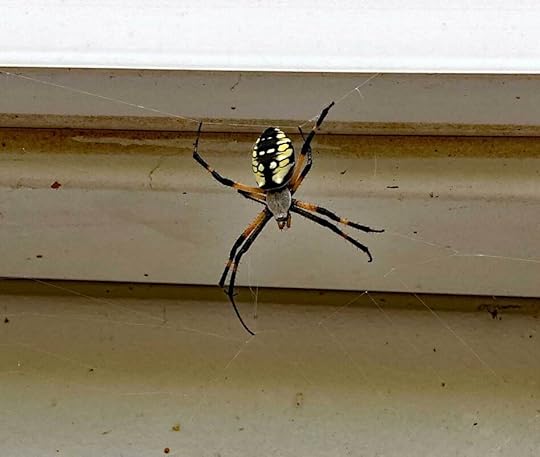
Black and yellow garden spiders typically live in grasslands, but they adapt well to living in gardens and on the sides of human-made structures. Although these large spiders produce venom to subdue their insect prey, the venom has almost no effect on humans, so they are considered harmless. Gardeners like having them around, as they consume a variety insect pests.
When an insect gets caught in the web, the garden spider will shake the web with its long legs, further entangling the insect. The spider injects its venom, paralyzing the prey, and wraps it in webbing, then leisurely sucks up all the juices, leaving only a dry husk. The spider, being a fastidious homemaker, will repair the damage to its web before settling in to consume the insect. These spiders usually create a web and then stay in that same spot for the entire season.

Published on October 04, 2023 09:42
September 30, 2023
Awesome Animal Fact - Hammer-headed Bat
Did you know male hammer-headed bats actually honk to get the attention of females? The hammer-headed bat, a fruit-eating bat and Africa's largest bat, is also one of the strangest looking bats I've ever seen.
Male hammer-headed bats, with a three-foot (0.91 m) wingspan, are more than twice the size of females. They are the most sexually dimorphic (meaning males and females are physically different) bat species in the world.
Why are the males so much larger? Because these bats have to sing to get sex. The males are highly physically adapted to create sounds that are pleasing to the females. The male's larynx (voice box) is half the length of its entire body, so large that the heart, lungs, and GI tract are arranged in different places to accommodate it. And the male's snout is greatly enlarged because of the large resonating chambers to increase sound production.
Male hammer-headed bats gather in groups, hanging upside down in the trees, and begin calling, emitting a loud metallic honking noise. Females hear this from a distance and come to choose a mate. The females are quite picky, and they fly by all the males, ignoring those with less pleasing calls, until they find a caller that meets their high standards.
Basically, it's a high-stakes sing-off.
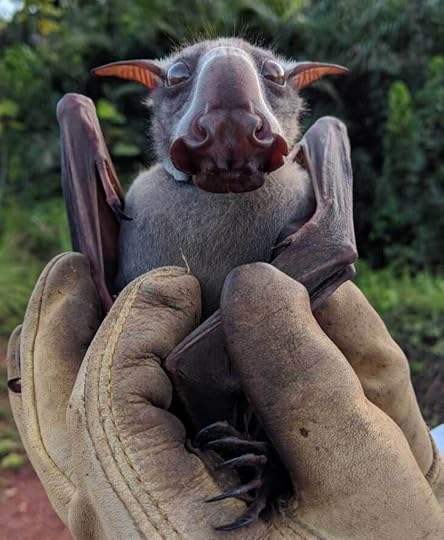
Photo Credits:
- Hammer-headed bat - Sarah H. Olson , Gerard Bounga, Alain Ondzie, Trent Bushmaker, Stephanie N. Seifert, Eeva Kuisma, Dylan W. Taylor, Vincent J. Munster, Chris Walzer, CC0, via Wikimedia Commons
Male hammer-headed bats, with a three-foot (0.91 m) wingspan, are more than twice the size of females. They are the most sexually dimorphic (meaning males and females are physically different) bat species in the world.
Why are the males so much larger? Because these bats have to sing to get sex. The males are highly physically adapted to create sounds that are pleasing to the females. The male's larynx (voice box) is half the length of its entire body, so large that the heart, lungs, and GI tract are arranged in different places to accommodate it. And the male's snout is greatly enlarged because of the large resonating chambers to increase sound production.
Male hammer-headed bats gather in groups, hanging upside down in the trees, and begin calling, emitting a loud metallic honking noise. Females hear this from a distance and come to choose a mate. The females are quite picky, and they fly by all the males, ignoring those with less pleasing calls, until they find a caller that meets their high standards.
Basically, it's a high-stakes sing-off.

Photo Credits:
- Hammer-headed bat - Sarah H. Olson , Gerard Bounga, Alain Ondzie, Trent Bushmaker, Stephanie N. Seifert, Eeva Kuisma, Dylan W. Taylor, Vincent J. Munster, Chris Walzer, CC0, via Wikimedia Commons
Published on September 30, 2023 05:25
September 26, 2023
Life's Great Mysteries - Why do we need a form of creative expression?
Not everyone likes to write, the way I and many of my family members do. However, as you get to know people, you realize everyone seems to have their own form of creative expression. I know a guy who restored an old 1940s pickup truck by meticulously replacing every part with a new part, then painting the truck his favorite color. We had a neighbor who spent endless hours modifying his family’s house and landscaping the yard. When he finally had it all done, they sold the house and moved so that he could start again on another house. Everyone tends to find some activity that allows them to express some creativity. Everyone wants to master some skill, or make something that pleases them or pleases other people.
Why not just exist? Why not sit on the couch and watch TV every spare moment? Wouldn’t it be easier to decide to never engage mentally in any form of creative expression? Wouldn’t it be easier to never make anything, or never master any skills?
I get great pleasure from crafting stories that I hope will entertain people. It is hard work, and each book requires countless hours of effort. I make some money from selling my books, but that is not really the reason I do it. I, like most everyone else, need a form of creative expression, and this is mine.
In solving this mystery, my first thought was that creative expression is an important component of our psychological development when we are children, and therefore we simply continue to like it as we grow older. But there may be more to it than simply holding on to a childhood tendency. It seems to be a universal part of our well-being. Throughout history, people have used dances, chants, pictures, and stories as a part of their healing rituals. Creative expression makes us healthy.
Perhaps a big part of it is that creative expression provides a glimpse into a person’s mind. It is a way of saying this is who I am. Perhaps we want to show the rest of the world who we are, or perhaps we want to discover who we are for ourselves.
Creative expression can be found almost anywhere...

Photo Credits:
- Garage painted with scenery - DepositPhotos
Why not just exist? Why not sit on the couch and watch TV every spare moment? Wouldn’t it be easier to decide to never engage mentally in any form of creative expression? Wouldn’t it be easier to never make anything, or never master any skills?
I get great pleasure from crafting stories that I hope will entertain people. It is hard work, and each book requires countless hours of effort. I make some money from selling my books, but that is not really the reason I do it. I, like most everyone else, need a form of creative expression, and this is mine.
In solving this mystery, my first thought was that creative expression is an important component of our psychological development when we are children, and therefore we simply continue to like it as we grow older. But there may be more to it than simply holding on to a childhood tendency. It seems to be a universal part of our well-being. Throughout history, people have used dances, chants, pictures, and stories as a part of their healing rituals. Creative expression makes us healthy.
Perhaps a big part of it is that creative expression provides a glimpse into a person’s mind. It is a way of saying this is who I am. Perhaps we want to show the rest of the world who we are, or perhaps we want to discover who we are for ourselves.
Creative expression can be found almost anywhere...

Photo Credits:
- Garage painted with scenery - DepositPhotos
Published on September 26, 2023 15:55
September 19, 2023
Awesome Animal Fact - Striped Bark Scorpion
Missouri only has one species of scorpion, the striped bark scorpion. They fascinate me, but I have a knack for getting stung. I've been stung three times (or is it four?), each time on my finger. Why? Because I can't resist turning over flat rocks to look for snakes and other critters hanging around under the rocks. The scorpions often cling upside down to the bottoms of these rocks, and when I put my fingers under the edge of a rock to lift it... pow!
Here's a striped bark scorpion I found recently.
These things pack a punch—about like a hornet or wasp sting. Not dangerous, but not fun. Some scorpions in other regions of the world are more dangerous.
By the way, scorpions are really ancient creatures. They've been around for at least 430 million years. At that time they were aquatic animals. They were among the first animals to adapt to living on land.
I know what you're thinking. Why didn't I learn to be more careful after the first encounter? I am more careful now. But still, I can't be sure it won't happen again.
Here's a striped bark scorpion I found recently.
These things pack a punch—about like a hornet or wasp sting. Not dangerous, but not fun. Some scorpions in other regions of the world are more dangerous.
By the way, scorpions are really ancient creatures. They've been around for at least 430 million years. At that time they were aquatic animals. They were among the first animals to adapt to living on land.
I know what you're thinking. Why didn't I learn to be more careful after the first encounter? I am more careful now. But still, I can't be sure it won't happen again.

Published on September 19, 2023 09:37
September 19th, 2023
Missouri only has one species of scorpion, the striped bark scorpion. They fascinate me, but I have a knack for getting stung. I've been stung three times (or is it four?), each time on my finger. Why? Because I can't resist turning over flat rocks to look for snakes and other critters hanging around under the rocks. The scorpions often cling upside down to the bottoms of these rocks, and when I put my fingers under the edge of a rock to lift it... pow!
Here's a striped bark scorpion I found recently.
These things pack a punch—about like a hornet or wasp sting. Not dangerous, but not fun. Some scorpions in other regions of the world are more dangerous.
By the way, scorpions are really ancient creatures. They've been around for at least 430 million years. At that time they were aquatic animals. They were among the first animals to adapt to living on land.
I know what you're thinking. Why didn't I learn to be more careful after the first encounter? I am more careful now. But still, I can't be sure it won't happen again.

Here's a striped bark scorpion I found recently.
These things pack a punch—about like a hornet or wasp sting. Not dangerous, but not fun. Some scorpions in other regions of the world are more dangerous.
By the way, scorpions are really ancient creatures. They've been around for at least 430 million years. At that time they were aquatic animals. They were among the first animals to adapt to living on land.
I know what you're thinking. Why didn't I learn to be more careful after the first encounter? I am more careful now. But still, I can't be sure it won't happen again.

Published on September 19, 2023 09:37
September 16, 2023
Awesome Animal Fact - Mind Control Worms
Did you know horsehair worms turn their insect hosts into suicidal zombies? That's a dramatic way to say it, but it's fairly accurate.
Horsehair worms are in their own phylum (Nematomorpha), with about 2,000 species worldwide. This is an estimate because we don't really know how many species there are. They all live in freshwater for part of their life cycle.
What about the other part of their life cycle? This is where things get bizarre. Adult horsehair worms mate in water, and the females lay eggs in water. When the eggs hatch, the young worms quickly form a protective covering called a cyst. These cysts are often eaten by insects, particularly grasshoppers and crickets. Once inside an insect, the protective covering dissolves, and the juvenile worm starts living inside the insect, absorbing nutrients from the food the insect eats. The worm grows bigger and bigger, sometimes weighing as much as the insect itself.
Here's the really weird part. When the worm becomes mature inside the insect, it has a chemical effect on the insect's brain—the insect is irresistibly drawn to horizontally polarized light. The result? The insect is drawn to water, and it inevitably jumps in and drowns.
Then the horsehair worm emerges from the drowned insect and swims away to find a mate, thus starting the cycle again.
I know it seems gross, but these kinds of interactions are amazing, don't you think?
The photo shows a horsehair worm that has emerged from a drowned grasshopper.
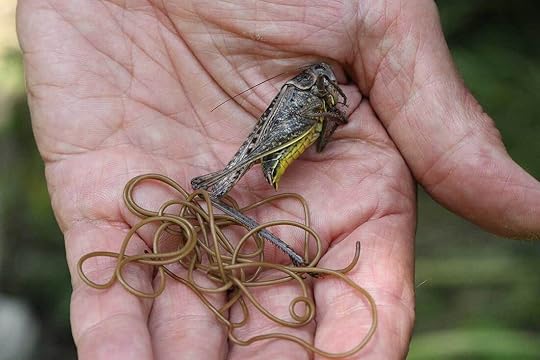
Photo Credits:
- Horsehair worm - Alastair Rae from London, United Kingdom, CC BY-SA 2.0, via Wikimedia Commons
Horsehair worms are in their own phylum (Nematomorpha), with about 2,000 species worldwide. This is an estimate because we don't really know how many species there are. They all live in freshwater for part of their life cycle.
What about the other part of their life cycle? This is where things get bizarre. Adult horsehair worms mate in water, and the females lay eggs in water. When the eggs hatch, the young worms quickly form a protective covering called a cyst. These cysts are often eaten by insects, particularly grasshoppers and crickets. Once inside an insect, the protective covering dissolves, and the juvenile worm starts living inside the insect, absorbing nutrients from the food the insect eats. The worm grows bigger and bigger, sometimes weighing as much as the insect itself.
Here's the really weird part. When the worm becomes mature inside the insect, it has a chemical effect on the insect's brain—the insect is irresistibly drawn to horizontally polarized light. The result? The insect is drawn to water, and it inevitably jumps in and drowns.
Then the horsehair worm emerges from the drowned insect and swims away to find a mate, thus starting the cycle again.
I know it seems gross, but these kinds of interactions are amazing, don't you think?
The photo shows a horsehair worm that has emerged from a drowned grasshopper.

Photo Credits:
- Horsehair worm - Alastair Rae from London, United Kingdom, CC BY-SA 2.0, via Wikimedia Commons
Published on September 16, 2023 05:55
September 10, 2023
Awesome Animal Fact - Massive Osprey Nests
There's an old hanging footbridge in Warsaw, Missouri. We decided to check it out recently, and we noticed an Osprey had built a nest at the very top of one of the supports.
Ospreys are large fish-eating raptors, with a wingspan of about six feet (1.8 meters). Chances are, you have seen an osprey, regardless of where you live. Why? Because the osprey is one of only six birds with a worldwide distribution (except Antarctica). Amazingly, this bird thrives in the warm tropics as well as in cold arctic regions.
See that huge nest the Osprey is sitting on? These birds like to make 'em big! They often add more sticks to their nests every year, and some nests have been reused over and over for up to seventy years. Not by the same bird, though, as ospreys only live to be about ten years old. These stick nests are often two meters across and weigh 300 pounds (135 kg).
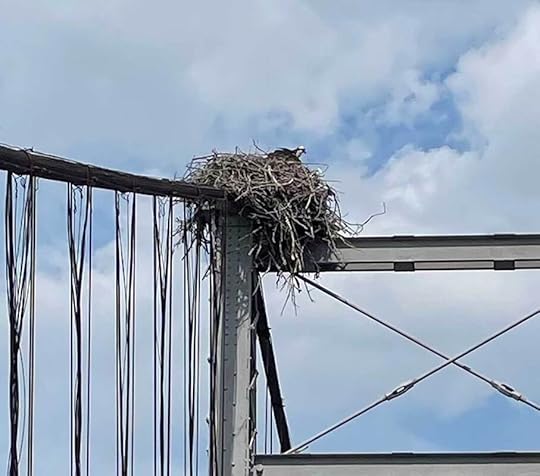
Ospreys are large fish-eating raptors, with a wingspan of about six feet (1.8 meters). Chances are, you have seen an osprey, regardless of where you live. Why? Because the osprey is one of only six birds with a worldwide distribution (except Antarctica). Amazingly, this bird thrives in the warm tropics as well as in cold arctic regions.
See that huge nest the Osprey is sitting on? These birds like to make 'em big! They often add more sticks to their nests every year, and some nests have been reused over and over for up to seventy years. Not by the same bird, though, as ospreys only live to be about ten years old. These stick nests are often two meters across and weigh 300 pounds (135 kg).


Published on September 10, 2023 14:15



